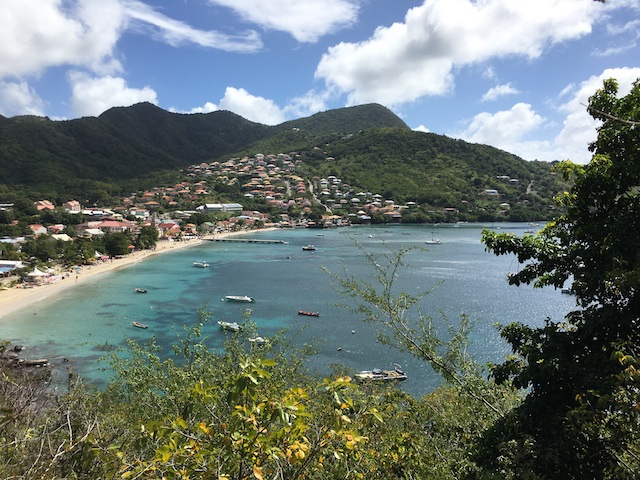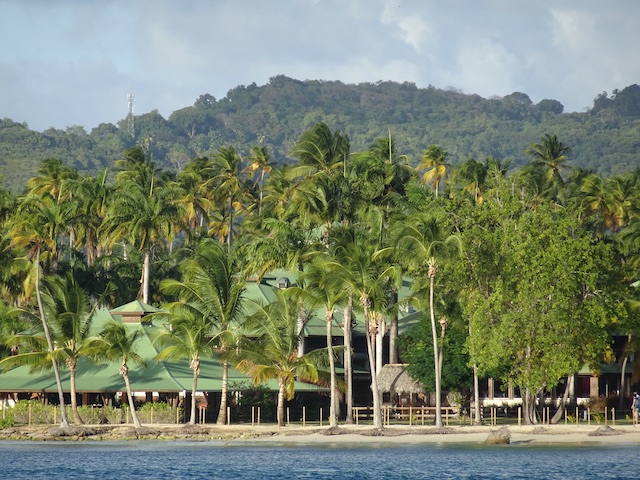The crossing from St Lucia to Martinique is only 25 miles but the trade winds are blowing hard creating boisterous conditions for the next few days. It is blowing 25-30 knots and a large sea state has built up in the Martinique channel with wave heights of three to four metres. We have had these conditions most of the way across the Atlantic so you may wonder why this is even worthy of mention. Although the wind is still from the North East, this time our course is North, and consequently we have 30-35 knots of apparent wind on the nose and the difference is dramatic. Our destination is St Anne but in this sea state we decide to bear off a little and blast across to the West coast of Martinique to a beautiful protected bay call Grand Anse D’Arlet.
The guidebook states that there are two supermarkets in the village, so with high expectations we tie up our dinghy at the large wooden dock and walk across the sandy beach to the tarmac road that winds up the hill through lush green jungle. The supermarket is a shack on the side of the road selling tinned food, crisps and loo rolls but not much else. Its sole occupant is a large black woman in a bright green dress. “Bonjour madame. Est ce que vous avez des fruits, des legumes?” She waggles a finger at me and shakes her head in Gallic disapproval, as if I was asking for something preposterous. She directs us up the hill to Petit Anse, paradoxically a larger village a kilometre away along the coast and once again it leaves us wondering why, in a land so fertile, there aren’t more vendors selling locally grown crops.
Splashes of bougainvillea in red, pink and yellow border the
tarmac road that drips with humidity; the peace broken by the occasional truck
that whines past in a cloud of fumes. After a short and very hot walk in the
mid morning sun we find ourselves in Petit Anse. The village is pretty with the ubiquitous air
conditioned pharmacy and a small church with a tall red spire, a few shops and some
restaurants. The fruit market comprises just two stalls under a green corrugated
iron roof, the produce mixed up haphazardly in wooden crates on the concrete
floor. We rummage through the boxes and find
sweet potatoes, papayas, passion fruit and precious avocados that have become a
key element of our recent pescatarian diet.
The bay at Grande Anse is sheltered from the East by a
backdrop of soaring green hills that are lush with vegetation and we soon find
out why. As the Easterly trade winds
chase the clouds across the Atlantic they become laden with moisture from the
warm evaporating sea and when they reach the hills of Martinique the clouds are
forced to rise. In the high cooler air the water vapour condenses and once it
reaches its dew point it falls from the sky in sheets of heavy rain that sweep
over the bay. The first few showers are welcome as they rinse down our salty decks
but after a few days we have had enough rain and we decide to brave the trade
winds and head East towards the sunnier climes of St Anne.
We are anchored a hundred metres off a picture postcard
Caribbean beach; a strip of white sand fringed with palm trees nodding in the
breeze and nearby the village of St Anne. The village is typically French with
a boulangerie that opens at 6 in the morning and has a permanent queue waiting
to buy baguettes, pains au chocolat, and other patisseries made in a way that
only the French can. A small covered
market near the beach is packed with brightly coloured stalls laden with herbs,
spices and bottles of rum. An elderly lady is spooning a thick pink paste into
a pan of hot oil. Within seconds they bubble to the surface and she spoons them
out onto kitchen paper. “Douze accras s’il vous plait” I venture and she gives
me a broad toothless smile and places an extra fish fritter in my hand to try.
It is hot and crispy with a soft spicy centre – just perfect for our picnic on
the beach.
We are with Simon and Sam, a young couple who were our
neighbours in Las Palmas before the ARC and are now doing an Atlantic circuit
on their Beneteau. We pick them up from their boat anchored nearby and set off by
dinghy for the beach at Les Salines, three miles to the south. It is a deserted
beach with just a few couples who have set up camp in the shade of the
Manchineel trees, dangerous if the milky sap drops on your skin but also the
only shade on the beach. The bay is
sheltered from the swell and is flat calm, the warm shallow water just cool
enough for idling and chatting while the midday sun climbs high in the
cloudless sky and warms our accras. Dipped in sweet chilli sauce they are the
perfect starter followed by tuna mayonnaise and salad baguettes from the
boulangerie.
We return to the boat at mid afternoon feeling exhausted,
but for no obvious reason. I am relieved to hear the following day that Simon
and Sam, thirty years younger than us, are also tired and that they had gone to
sleep at nine the previous evening, even earlier than us. Caroline has a theory about our constant
state of fatigue which goes as follows: The lead up to a transatlantic crossing
involves so much preparation and planning that by the time one leaves the
shores of Europe one is already tired. The two-week crossing features broken
sleep, a constant state of alertness and the weight of responsibility that
comes with taking friends and a boat across one of the world’s great oceans. Her
explanation for our fatigue is that it is only now that we are anchored safely
that our bodies slow down and rest to properly recover from the past few months
of stress.
We leave St Anne and head north up the west coast of
Martinique to the town of St Pierre where we anchor overnight before sailing
North to Dominica where we are meeting Saz and Rosie. On the way we pass a small volcanic islet
named Diamond Rock, now a haven for seabirds but with a more exotic and violent
past. In 1804 the British landed 120 sailors who built barracks within the rock’s
caves and reinforced it with canons. The Royal Navy then registered the yacht
as a fighting ship, the unsinkable HMS Diamond Rock, and for the next 18 months
used it to harass French vessels negotiating the channel. French attempts to capture
the Rock were unsuccessful until Admiral Villaret (later defeated by Nelson at
the battle of Trafalgar) cut loose a skiff loaded with rum that drifted onto
the Rock. The isolated English sailors glugged down the hooch and the French
forces retook the island.
We love the French islands. The combination of beautiful
scenery, primitive communities but within striking distance of sophisticated
French cuisine makes for a delicious recipe. We are looking forward to our next
destination at Les Saintes, a small archipelago of islands off the south coast
of Guadeloupe where some of the locals can trace their ancestors back to the
early seafaring Norman and Breton colonists.












Frewy justifying his perpetual state of snooziness....? Well, well.
ReplyDeleteSounds dreamy - wishing you love, rest and fair winds x
ReplyDelete